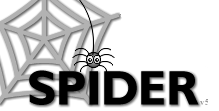 About SPIDER
About SPIDER
 What is SPIDER?
What is SPIDER?
Strathclyde Personal Interactive Development & Educational Resource (SPIDER) started development in December 1998 as a web project to convert a single teaching module (class) into an interactive web environment. The success of this single module lead to the inclusion of more classes on the site. At this point, SPIDER was a "static" website, essentially all hand coded using plain HTML, the language used to describe web pages. This was a major flaw - as more and more material came to be added to the system, with only one developer, hand editing HTML became too time consuming.
Over several months SPIDER was modified to be more dynamic, following the emerging trend in website design - dynamic, database generated sites. The chosen technology was Linux based, using Apache (web server), PHP (scripting) and MySQL (database).
In March 2001, "SPIDER II" was released, an entirely dynamic, database backed system. All users logged in and could customise the environment to their own needs. Several user groups were created, determining users access rights on the system. The dynamic nature of the site also allowed for the implementation of many more features and tools, such as discussion boards, the quiz monitoring system (SQuID), news postings and more. The School of Pharmacy by this time had decided that SPIDER was to contain all material relating to the MPharm degree and many classes had compulsory sections entirely based on SPIDER. The other Bioscience & Biomedical degrees also benefited from the SPIDER technology as a sister site "BRUCe" was developed in tandem to cater for the staff and students related to these courses.
SPIDER III was launched around April 2002 with further improved tool sets, increased functionality, and a modularised development environment. SPIDER was now not only used to deliver support material for teaching, it became integral to a number or courses and vital for numerous departmental management tasks and database systems.
 Evolution of the Web
Evolution of the Web
In the summer of 2003, SPIDER and BRUCe were combined during the move to the current faculty wide SPIDER system, with their content grouped into two "clusters". Clusters offer a means of grouping material and information in a way that emulates the university degree model. SPIDER now caters to all undergraduate and a number of postgraduate courses run by all 10 departments in the Science Faculty. Strathclyde Business School also make use of the system, currently having three postgraduate courses being delivered via SPIDER. The Faculty of Eduction and the Faculty of Law, Arts and Social Sciences are started to make use of the system (for session 2005-06) for a variety of classes and/or to support ePDP. By November 2005 there were over 11,000 registered SPIDER users, with around 4500+ visiting the site each week, and over 700 different classes containing a variety of materials, presented within 14 clusters.
By the start of session 2008-09, SPIDER had grown to over 26,000 users (Staff: 1318, Student: 14549, Alumni: 10338 on Oct 23 2008), with 6100+ weekly visitors, and over 10,000 users visiting each academic semester. There are over 1,100 classes contained within 19 clusters catering to over 150 degree programmes.
- Timeline of SPIDER developments
For all the latest developments on SPIDER see the SPIDER-Development system or read the SPIDER newsletters
 SPIDER Abroad
SPIDER Abroad
SPIDER has also been installed on-site at the International Medical University (IMU), Kuala Lumpur, Malaysia, as part of the Twinned Pharmacy programme, which caters to around 500 users.
 More information
More information
PowerPoint PresentationsSPIDER update 2005 Nov 2005
A look at the status of SPIDER toward the end of 2005
SPIDER update 2008 Oct 2008
A look at the status of SPIDER toward the end of 2008 - update of above with latest facts and figures
SPIDER introduction Oct 2008
Slides used as part of the Faculty of Science induction day for new entrants
home | help | help wiki | documentation | training guides | quick start
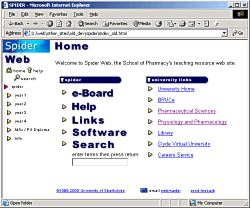
SPIDER v1 home page
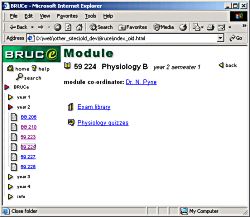
BRUCe v1 "module" home page
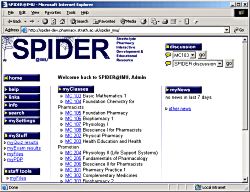
SPIDER II home page - users could now login and customise the site
![SPIDER III [faculty] home page](spider/pics/about/spider_3_home.jpg)
SPIDER III 'faculty' home page
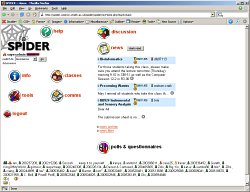
SPIDER V home page - the current version of SPIDER
